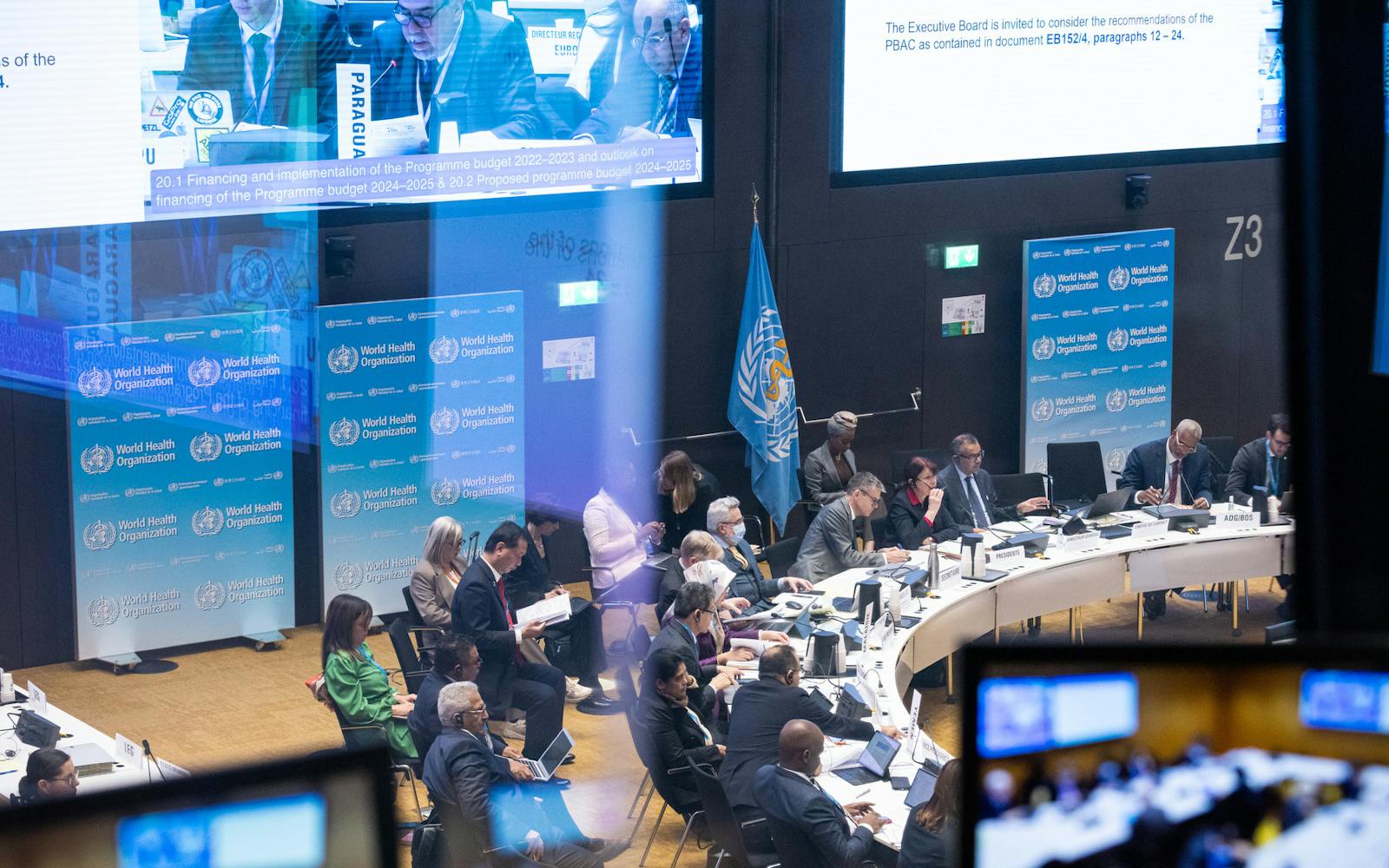
Government officials and delegates gather at the 152nd session of the WHO Executive Board at the UN agency’s headquarters in Geneva, Switzerland, in January 2023. Photo: WHO / Pierre Albouy
As the world confronts a growing number of unprecedented and unpredictable threats to our collective well-being, government officials and dignitaries will gather in Geneva this month to lay out a plan to protect and promote global health in 2024.
Every January, the Executive Board of the World Health Organization (WHO) meets at the UN agency’s headquarters in Switzerland to establish priorities for the year ahead and set the agenda for the World Health Assembly in May, when all 194 UN Member States convene to drive global progress toward better health for everyone, everywhere.
Right now conflict, extreme weather, and rising levels of food insecurity and poverty are wreaking havoc on our health, especially the most vulnerable among us, while testing the international community’s capacity and political will to respond. The upcoming Board meeting is expected to cover a wide range of challenges, from the impact of violence in Gaza and Ukraine to the effects of plastic and chemical pollution on the human body, as well as major milestones this year, like the 50th anniversary of the UN’s expanded immunization program. Underpinning all of this is the urgent need for universal health coverage.
2024 is also expected to be a major year for immunization, with the rollout of two new malaria vaccines and two new polio vaccines, bringing the world closer to eradicating some of the planet’s deadliest diseases.
Another massive yet microscopic threat that will top the agenda: antimicrobial resistance, a health risk that knows no borders and will require a whole-of-UN response.
This year could also witness major reforms in how WHO is funded and a potential overhaul in the agency’s approach to emergency prevention, preparedness, and response.
Ahead of this month’s meeting, I spoke with two UN Foundation colleagues, Senior Director for Global Health Lori Sloate and Global Health Policy Officer Molly Moss, about the most critical issues on this year’s agenda.
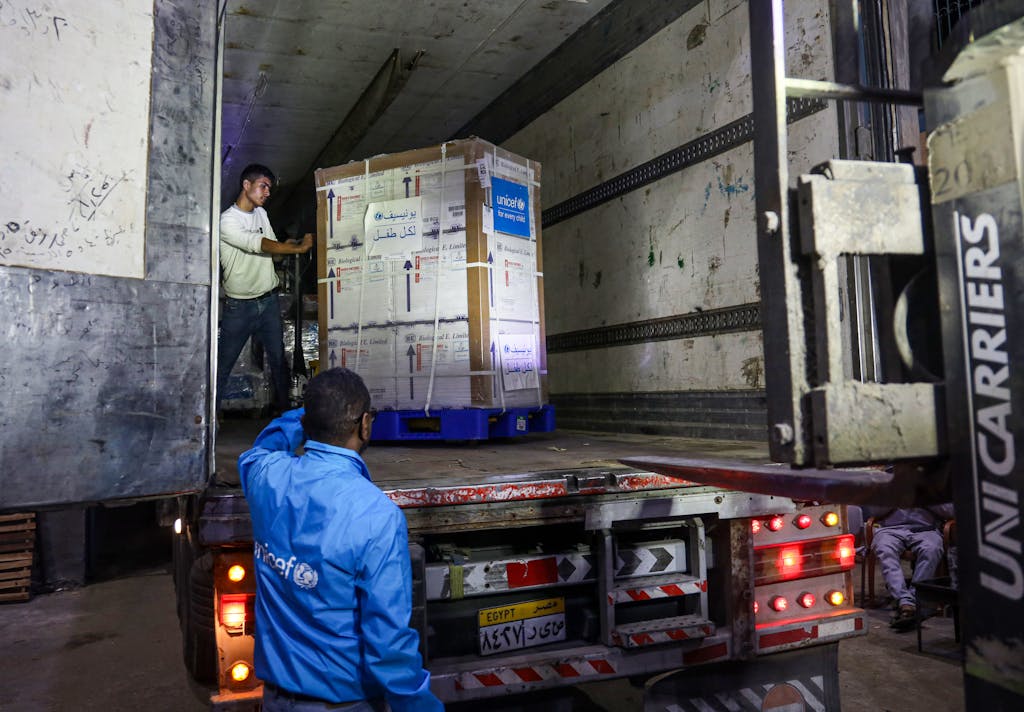
A shipment of vaccines is unloaded in Gaza as part of an emergency response by UNICEF and other partners to protect Palestinian children who have missed routine childhood immunizations against measles, pneumonia, polio as a result of the ongoing conflict. Photo: UNICEF / Eyad El Baba
HUMANITARIAN CRISES
During a special session in December, WHO’s Executive Board adopted a resolution on Gaza calling for “immediate, sustained and unimpeded passage of humanitarian relief, including the access of medical personnel.” And at the most recent World Health Assembly in May, the agency passed a resolution condemning the violence in Ukraine and calling for Russia to stop attacking health facilities.
How will WHO’s Executive Board address these crises along with other escalating humanitarian health care needs all over the world?
Lori: WHO is the leading UN agency for health, so it essentially serves as the health cluster lead in the Palestinian territories and works with various partners, including other UN agencies, governments, and health authorities. Although access in Gaza is limited, WHO is coordinating efforts, including direct provision of medical supplies, logistics, and support for urgent lifesaving needs. WHO also negotiates to protect health care workers, hospitals, and health facilities. In Ukraine, WHO has delivered an estimated $120 million worth of health supplies since March 2023, reaching roughly 7 million people.
Molly: As time goes on, we are seeing WHO as more of an operational actor in conflict and crisis settings. Whether it’s delivering tons of medical supplies or surging a health workforce or conducting surveillance of attacks on health care, there is an increasingly operational element to what WHO does. The situation in Gaza is a very clear example of that, but there are plenty of other conflict settings, like Afghanistan, Sudan, and Ukraine, where WHO has been asked by UN Member States to step up and fill a void in humanitarian health care. This year’s agenda includes the Global Health and Peace Initiative, which reflects WHO’s growing role in humanitarian emergencies and outlines a broader conceptual framework that recognizes we can’t achieve health when there is no peace and we can’t achieve peace without robust and sustainable health systems.
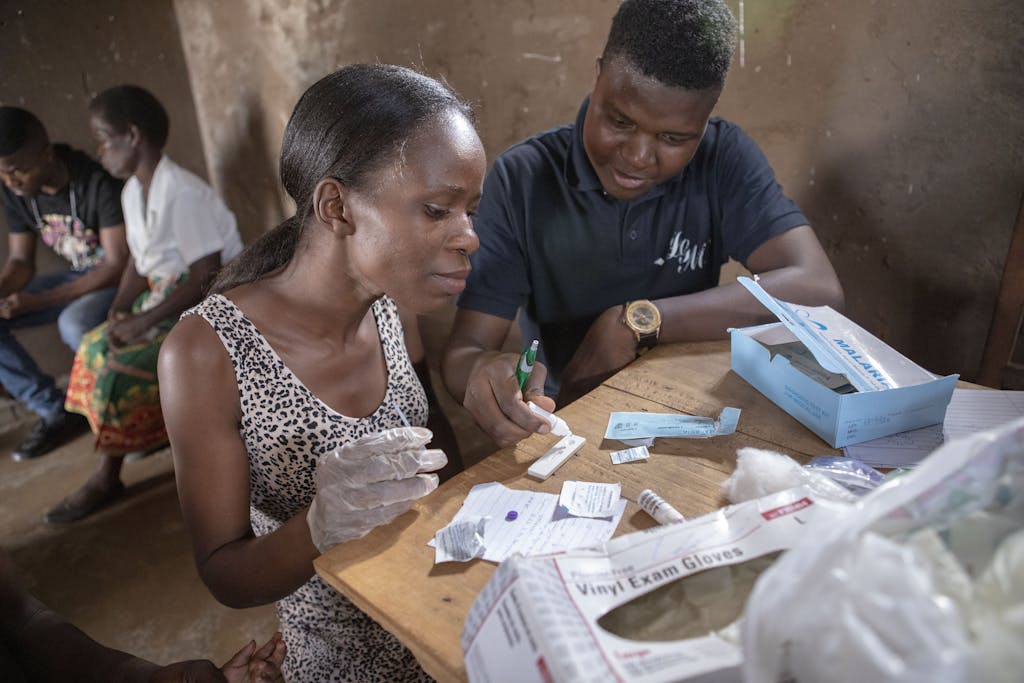
WHO provides urgent health assistance after Cyclone Idai displaced thousands of people in Mozambique, Malawi and Zimbabwe in 2019, putting the most vulnerable at increased risk of malaria, typhoid and cholera. Photo: WHO / Mark Nieuwenhof
WHO IN EMERGENCIES
The Board will hear a new update on strengthening global architecture for Health Emergency Prevention, Preparedness, Response and Resilience (HEPR) just weeks before the fourth anniversary of the COVID-19 pandemic outbreak. Meanwhile, UN Member States are negotiating a pandemic accord.
Though the pandemic accord is not an official agenda item at the EB meeting, it will be one of the hottest topics of discussion. Can you shed some light on where negotiations on the pandemic accord stand and what comes next?
Molly: Although the accord is not officially on the agenda, the co-chairs of the negotiation process will provide a brief, informal update on the first day of the EB meeting. All eyes are on the process as Member States embark on the most intense phase of negotiations this February and March. One of the most fundamental sticking points is the issue of intellectual property, specifically, how developing economies can create vaccines and other pandemic response products that will enable them to mount their own domestic or regional response and not depend on high-income, developed economies for charity. One of the ways that Member States have found traction on this issue called a Pathogen Access and Benefit-Sharing System. There is a precedent for this system in how the world shares influenza samples through WHO’s Global Influenza Surveillance and Response System.
The elephant in the room is that there are lots of national elections in 2024, including in the U.S., and the potential for changes in political leadership. So the upcoming World Health Assembly in May is widely seen as a hard deadline to finalize the pandemic accord.
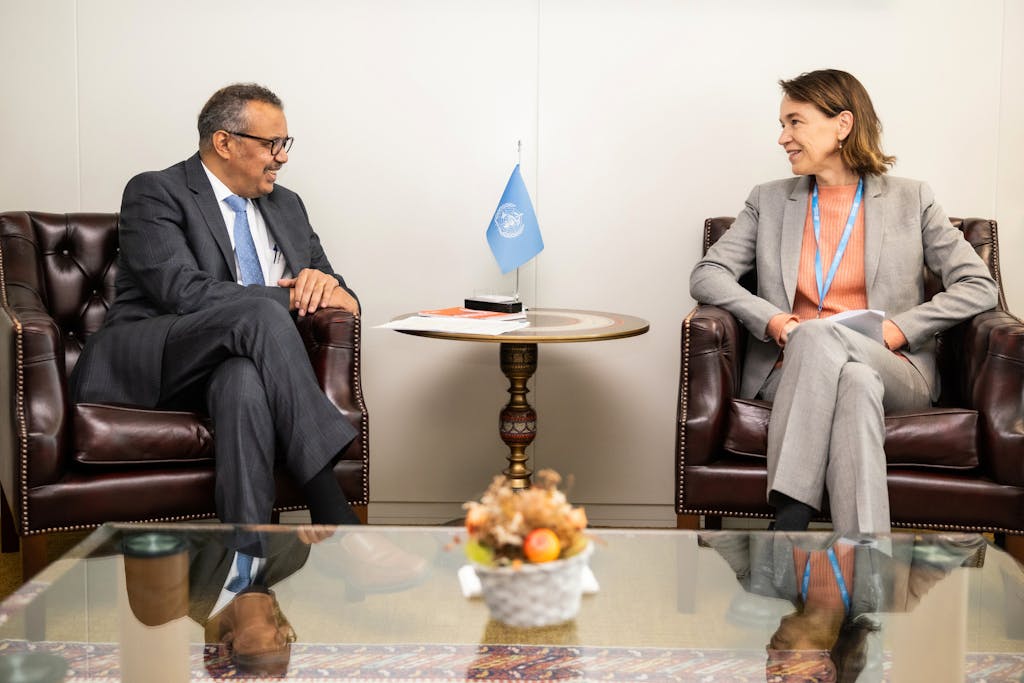
WHO Director-General Dr. Tedros Adhanom Ghebreyesus meets with Olivia Wigzell, Sweden’s Director-General of The National Board of Health and Welfare, at the agency’s Geneva headquarters to discuss sustainable financing, the health crisis in Ukraine, and the importance of prioritizing data.
Photo: WHO / Pierre Albouy
FINANCING WHO
The future effectiveness of WHO will largely depend on changing how the agency is funded, so it has more sustainable, predictable, and flexible financing to meet the increased expectations of what the agency can deliver. Progress has been made to increase the percentage of assessed contributions in the form of Member State dues, but far more flexibility and predictability in voluntary contributions will be needed to meet this moment.
How did COVID-19 accelerate calls for such reforms, and how will the upcoming Board meeting move this process forward?
Molly: When the pandemic hit, WHO’s health emergencies budget was grossly underfunded. Then suddenly, WHO had all of these countries and citizens around the world turning to the agency and saying, “What do we do in response to COVID-19?” And the agency had peanuts in the bank to mount a response. That’s why the COVID-19 Solidarity Response Fund became so important. COVID-19 really did spark a reckoning within WHO about what Member States expect it to do and what they actually empower the agency to do through their financing.
Lori: Previously, WHO’s budget was only 16% funded by assessed contributions. By 2030, 50% of WHO’s budget will come from assessed contributions. But that still leaves the remaining half as voluntary and, therefore, unpredictable and unsustainable. Voluntary contributions are basically earmarked funding from Member States, the private sector, and philanthropies for specific projects they want to fund. So in a large sense, WHO’s budget has been at the whim of donors, creating these pockets of poverty in their operations for which donors are less inclined to designate funds. Immunization, for example, is well financed, but then something like cancer control is not. WHO’s next strategy, known as the “General Program of Work,” will cover 2025 to 2028 so the agency is seeking as much funding as possible — $7.1 billion — upfront to cover that four-year period, and for this funding to be as flexible as possible.
At the same time, you have major replenishments happening for the Global Fund to Fight AIDS, Tuberculosis and Malaria and GAVI, the Vaccine Alliance. Then, when you add unforeseen emergencies and what’s happening in Ukraine and Gaza along with climate change, for example, there are a lot of fiscal demands on governments. And that creates a really challenging fiscal environment for global health.
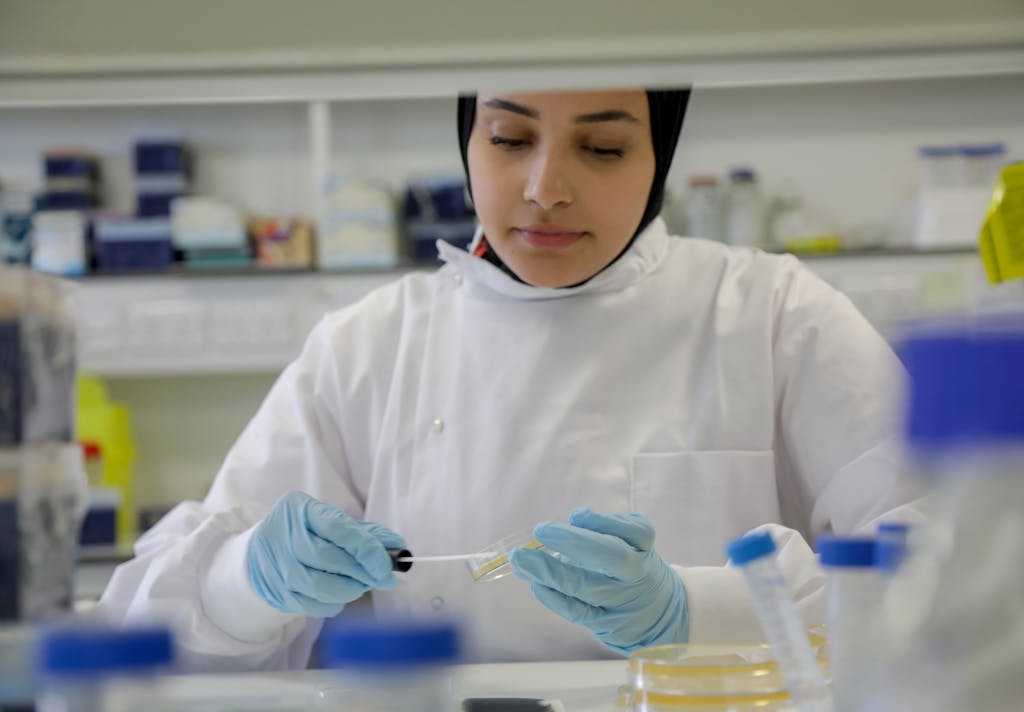
At the Liverpool School of Tropical Medicine, researchers are studying personalized antimicrobial therapy as a way to prevent and treat AMR, a growing and global threat that undermines decades of medical advancement. Photo: DFID / Will Crowne
ANTIMICROBIAL RESISTANCE
AMR threatens the core of modern medicine and puts every nation at risk for the spread of deadly infectious disease. WHO will be prioritizing the issue at the upcoming Board meeting.
Why now?
Molly: The reason antimicrobial resistance is taking center stage at this year’s Executive Board meeting is threefold. First, AMR is a growing and existential threat, and it hasn’t seen the kind of sustained political attention that it demands. Second, WHO’s global action plan on antimicrobial resistance, which was adopted in 2015, is coming to an end in 2025. So Member States need to be talking this year about what the next 10-year road map looks like. And the third reason is that there will be a High-level Meeting on Antimicrobial Resistance at the UN General Assembly in New York this September. So I think 2024 will go a long way toward putting AMR high on the agenda in different forums, including outside of the human health space.
Lori: For context, there hasn’t been a High-Level Meeting on antimicrobial resistance at the UN since 2016, and a lot has happened since then to coordinate the four UN agencies that work directly on this issue: WHO, the UN Environment Programme, the World Organisation for Animal Health, and the Food and Agriculture Organization. AMR cuts across many sectors and actors. How do you coordinate that agenda globally? I think this year’s High-Level meeting will be a bit more programmatic in that countries are looking to set targets for what they want to achieve on the AMR agenda in 2024.
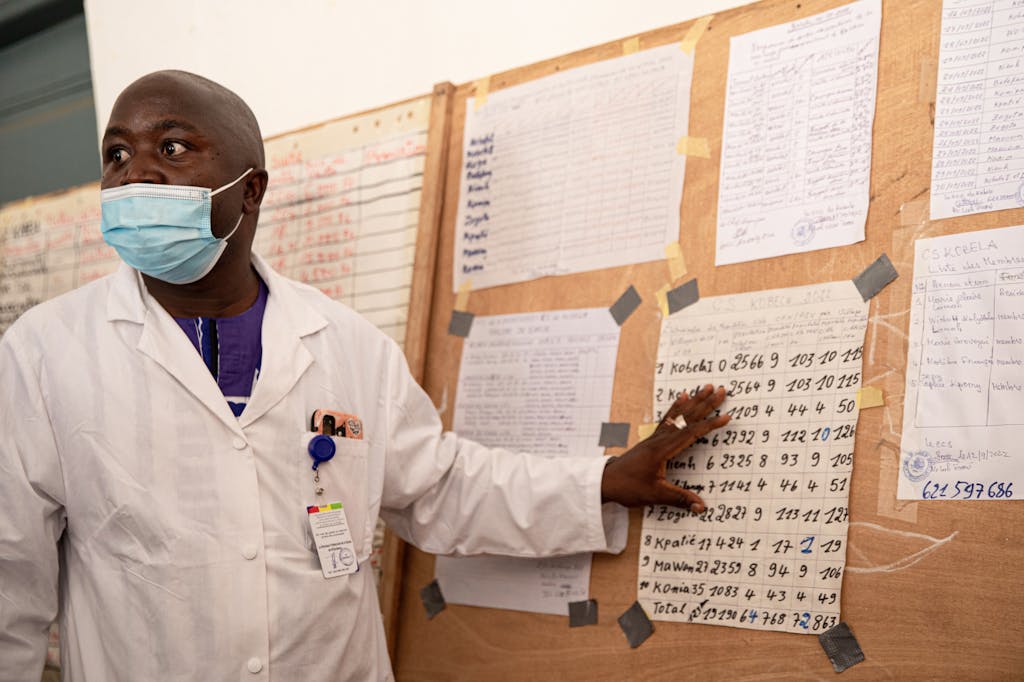
The head of the Kobéla Health Center in Guinea presents data on local prenatal consultations and vaccination rates. Over the past two decades, Guinea’s Ministry of Health and Public Hygiene has prioritized maternal, newborn, and child health through more accessible primary health care. Photo: UNICEF / Sibylle DesJardins
UNIVERSAL HEALTH COVERAGE
WHO and the World Bank recently released their latest global monitoring report on universal health coverage (UHC), a crucial target for the Sustainable Development Goals. It found that over half of the planet’s population lacks access to essential medicines and that a significant portion faces financial hardship as a result of unaffordable health services.
How will this sobering data shape the conversation in Geneva?
Molly: The data in this report shows the stark reality of where we are on the UHC agenda. In fact, UN Member States convened a High-Level Meeting on UHC during the 2023 General Assembly in New York, where governments committed to redoubling their efforts to achieve UHC goals. The Executive Board will ask governments what these commitments actually look like: What kind of finances do we need to make these a reality? How are those finances going to be brought to bear? Will it be through national budgets, official development assistance, or other sources? These are the kind of discussion questions that UN Member States will be asked to reflect on.
Lori: In addition to financing, the Executive Board will discuss how countries plan to implement political commitments made under the UHC declaration. Member States agreed to redouble efforts to achieve UHC by reorienting health systems through a PHC approach. How are countries going to do this and what are some examples of countries who have shown impact? It’ll be interesting to see how this overarching challenge comes up throughout the agenda. And finally, we expect there to be a resolution on Institutionalizing social participation for health and well-being.
Stay Informed
Looking for the latest updates on global health and sustainable development? Sign up for the UN Foundation’s Unite for Health newsletter, which tracks action on the 2030 Agenda from the grassroots level to UN Headquarters.
from Humanitarian activities – My Blog https://ift.tt/PC1bgcJ
via IFTTT


